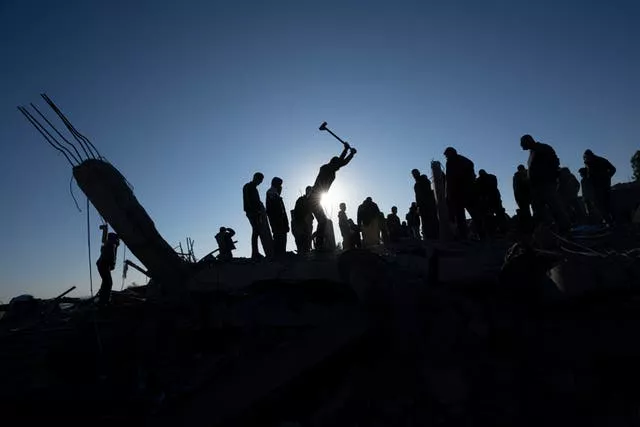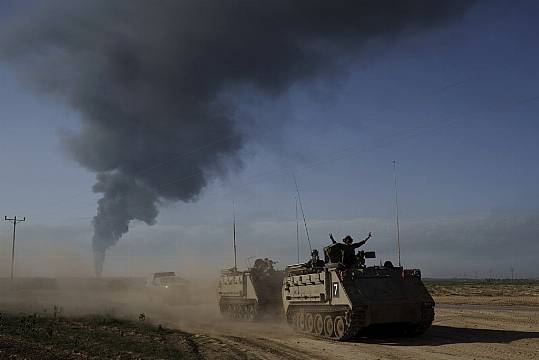Israeli air strikes in central Gaza killed at least 18 people, including children, a day after 33 were killed at a United Nations-run school sheltering displaced Palestinian families, health officials said.
Overnight strikes were recorded at the Nuseirat and Maghazi refugee camps and the towns of Deir al-Balah and Zawaiyda.
Four children and one woman were among those killed as well as the mayor of the Nuseirat municipality, according to hospital records.

Meanwhile, Israel’s army said it is continuing operations in parts of Central Gaza. It said its troops had killed dozens of militants, located tunnel shafts and destroyed infrastructure in the area.
The strikes came a day after at least 33 people were killed at a UN-run school in the Nuseirat refugee camp which Israel said was being used as a Hamas compound, without providing evidence.
International pressure has been mounting on Israel to limit civilian bloodshed in its war against Hamas.
Spain’s foreign minister has announced it would ask a United Nations court for permission to join South Africa’s case accusing Israel of genocide in Gaza. Israel strongly denies the accusation.
More than 36,000 Palestinians have been killed by eight months of Israeli bombardments and ground offensives in Gaza, according to the health ministry, which does not distinguish between combatants and civilians.

The war has largely cut off the flow of food, medicine and other supplies to Palestinians who are facing widespread hunger.
United Nations agencies say over one million in Gaza could experience the highest level of starvation by mid-July.
Later, US Central Command announced that a key section of the US military-built pier designed to carry badly needed aid into Gaza by boat has been reconnected to the Gaza beach following storm damage repairs, and aid will begin to flow soon.
The section that connects to the beach, the causeway, was rebuilt nearly two weeks after heavy storms damaged it and abruptly halted what had already been a troubled delivery route. Humanitarian aid is expected to begin moving into the enclave through the maritime route in the coming days.
A large section of the causeway broke apart on May 25 as heavy winds and high seas hit the area, and four US army vessels operating there went aground, injuring three service members, including one who remains in critical condition.
The damage was the latest stumbling block in what has been a persistent struggle to get food to starving Palestinians.
Bad weather had earlier slowed the delivery of sections of the pier and US military personnel from Virginia to the region. And early efforts to get aid from the pier into Gaza were disrupted as residents stormed the trucks that aid agencies were using to transport the food to the warehouses for distribution.

The maritime route for a limited time had been an additional way to help get more aid into Gaza because the Israeli offensive in the southern city of Rafah has made it difficult, if not impossible at times, to get anything through land routes that are far more productive. US President Joe Biden’s administration has said from the start that the pier was not meant to be a total solution and that any amount of aid helps.
Because of the storm damage to the causeway, large sections were disconnected and moved to the Israeli port for repairs.
Two of the US army boats went aground near Ashkelon in Israel, but those have been freed, and the other two beached onto the Gaza shoreline. Pentagon spokeswoman Sabrina Singh said those two took on a lot of water and sand and that the Israeli Navy has been helping with the repairs.
Mr Biden, a Democrat, announced his plan for the American military to build a pier during his State of the Union address in early March, and the military said it would take about 60 days to get it installed and operational.
The initial cost was estimated at 320 million dollars (£250 million), but Ms Singh said earlier this week that the price had dropped to 230 million dollars (£179 million), due to contributions from Britain and because the cost of contracting trucks and other equipment was less than expected.
It took a bit longer than the planned two months for installation, with the first trucks carrying aid for the Gaza Strip rolling down the pier on May 17.
Just a day later, crowds overran a convoy of trucks as they headed into Gaza, stripping the cargo from 11 of the 16 vehicles before they reached a UN warehouse.
The next day, as officials altered the travel routes of the convoys, aid finally began reaching people in need. More than 1,100 tonnes (1,000 metric tonnes) of aid were delivered before the causeway broke apart in the storm, Pentagon officials said.
Israel launched the war after Hamas’ October 7 attack, in which militants stormed into southern Israel, killed some 1,200 people – mostly civilians – and abducted about 250.
Around 80 hostages captured on October 7 are believed to still be alive in Gaza, alongside the remains of 43 others.







